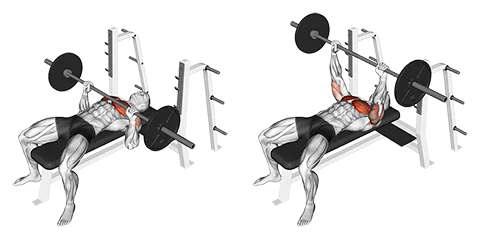Introduction
The barbell bench press is a strength training exercise focusing on the chest muscles (pectorals). It primarily strengthens the upper body and improves pushing power. This exercise is effective for building a strong, well-defined upper body, particularly targeting the pectorals, triceps, and shoulders – ideal for individuals aiming to increase muscle mass or improve overall fitness.
Muscles Worked
- Primary: Chest (Pectoralis Major and Pectoralis Minor), Shoulders (Anterior Deltoid)
- Secondary: Triceps (Triceps Brachii), Front of the Arms (Biceps Brachii, Brachialis), Core (Rectus Abdominis)
How to Do It (Step-by-Step)
- Position the barbell on a power rack at a height just below your chest level. Lie flat on the bench with feet shoulder-width apart and grip the barbell at a width slightly wider than shoulder-distance apart. Unrack the barbell by straightening your arms.
- Lower the barbell to your chest, keeping it close to your body throughout the movement. Pause briefly at the bottom position.
- Drive the barbell back up by extending your elbows and pushing the barbell back to the starting position. Maintain a tight core and keep your glutes on the bench for stability.
Tip: Make sure to breathe effectively during the exercise, inhaling as you lower the barbell and exhaling as you push it back up. This can help you maintain control and avoid injury.
Rep & Rest Guidelines
- Strength: 4–6 reps, 2–3 min rest
- Hypertrophy: 8–12 reps, 60–90 sec rest
- Endurance: 12–20 reps, 30–60 sec rest
Using Auto Progression Auto Progression to adjust weights based on performance can help optimize your workouts. A Rest Timer Rest Timer ensures you get the right rest between sets, improving workout efficiency and recovery.
Form Tips
- Maintain a tight grip on the bar: Keep your hands shoulder-width apart and grasp the bar with a pronated (overhand) grip. The knuckles should be facing forward, wrists straight. This helps to stabilize the barbell and prevent injuries during the lift.
- Arch your back slightly: To protect your spine, arch your lower back and engage your core muscles. This will help you maintain a neutral spine throughout the lift, reducing the risk of injury and improving overall form.
- Lower the bar to your chest properly: Keep the bar close to your body as you lower it, aiming for it to touch just above your nipple line. Bend your elbows at approximately 45 degrees from your torso, and avoid flaring them outward or letting them drop too low. This will ensure a smooth and controlled descent and ascent of the barbell during the bench press.
When to Use It
- Building a strong upper body for sports like football or weightlifting
- Targeting the chest and shoulder muscles for a balanced physique
- Increasing pushing strength for functional fitness competitions
Workout History is essential for tracking your progress over time.
The primary muscles worked are the chest (pectoralis major), shoulders (deltoids), and triceps. The core stabilizes the body during the lift.
Lie on a flat or slight incline bench, feet flat on the floor, grip the bar at shoulder width, unrack the bar, lower it to your chest, push up, and lock out elbows at the top.
A common scheme is 3-4 sets of 8-12 reps, adjusting based on your goals (strength or muscle growth) and progress.
Start with a weight that allows you to perform the recommended number of sets and reps while maintaining proper form.
Using a spotter can help ensure safety, particularly when lifting heavy weights. However, always aim for self-sufficiency when possible.



